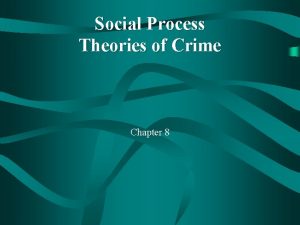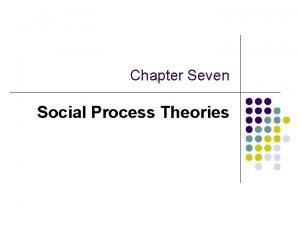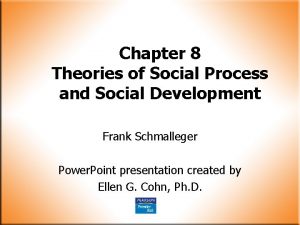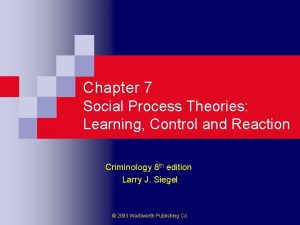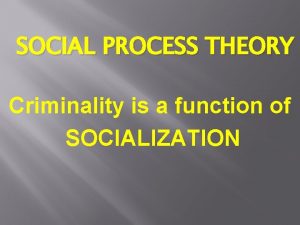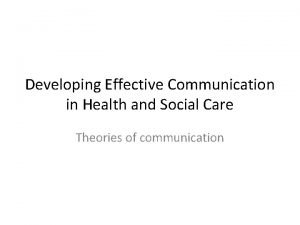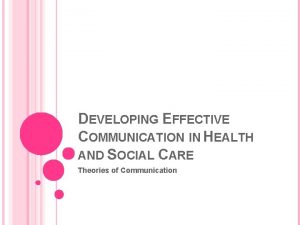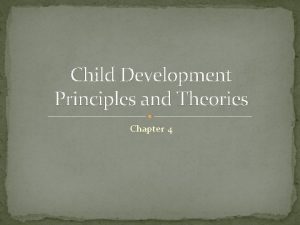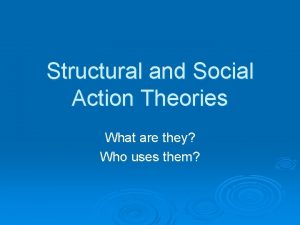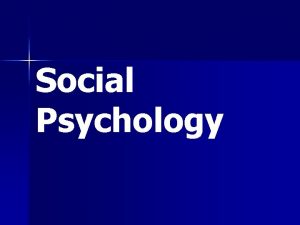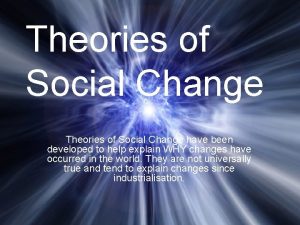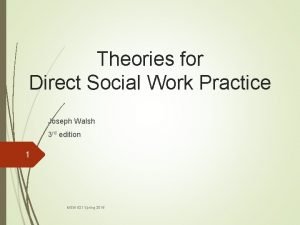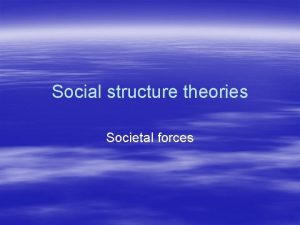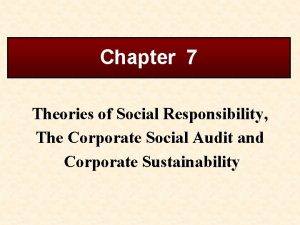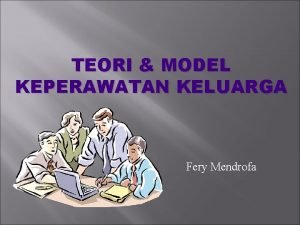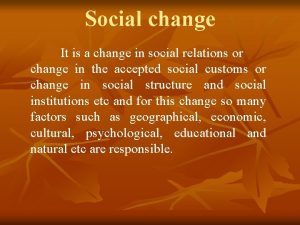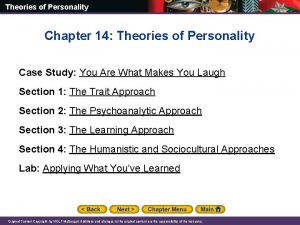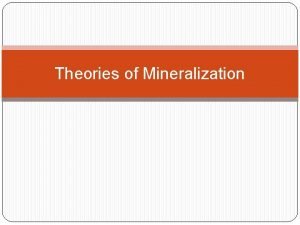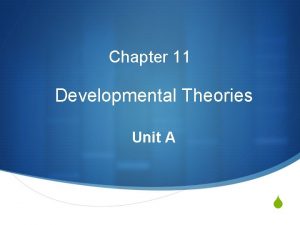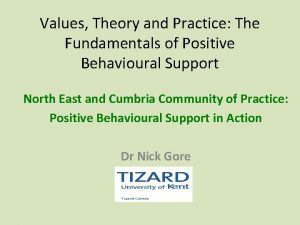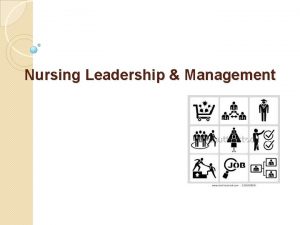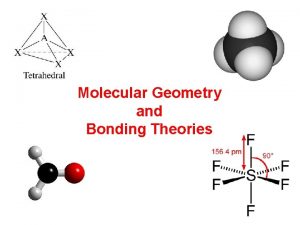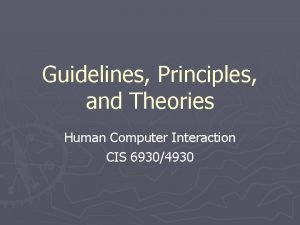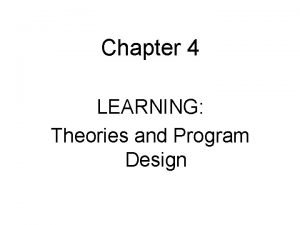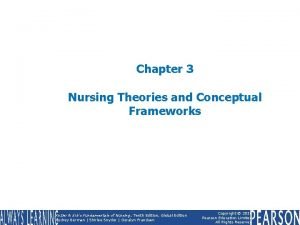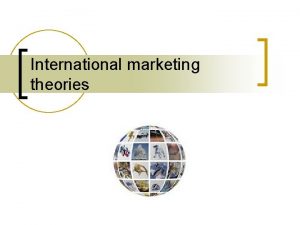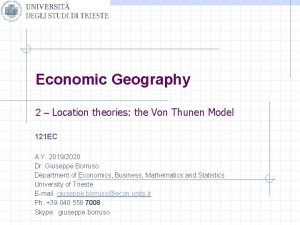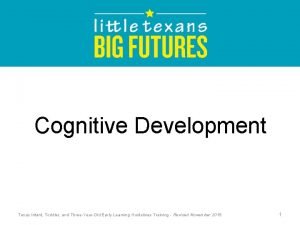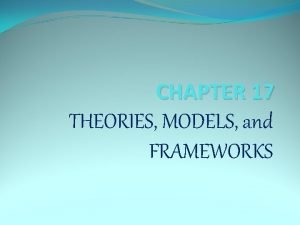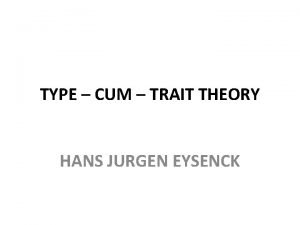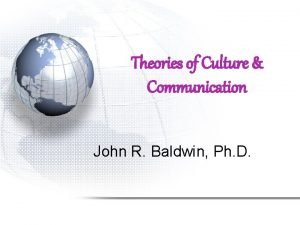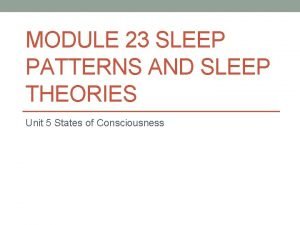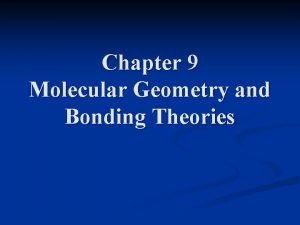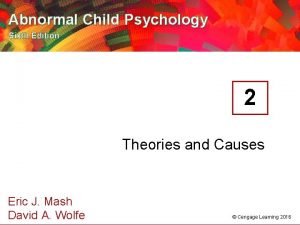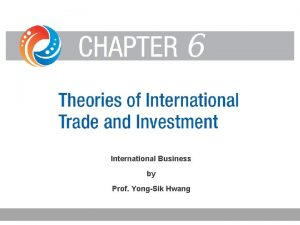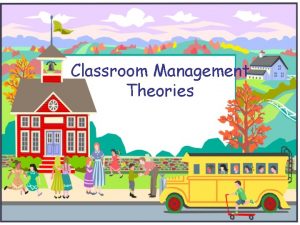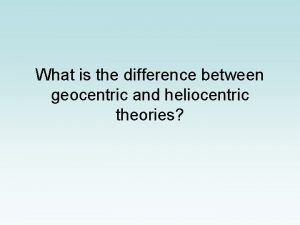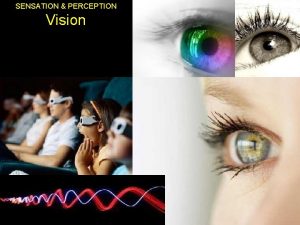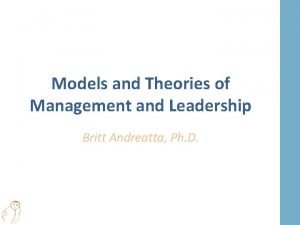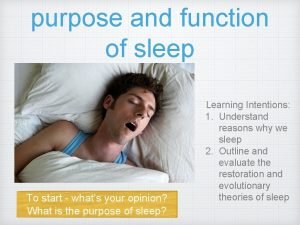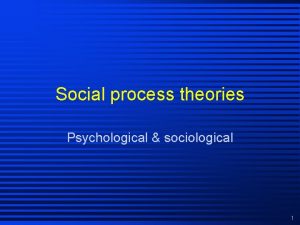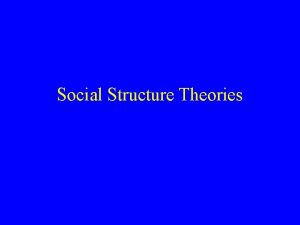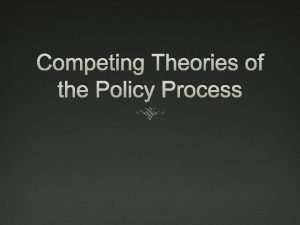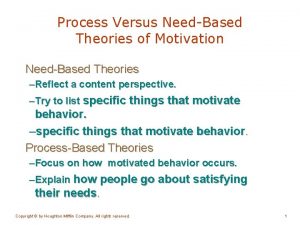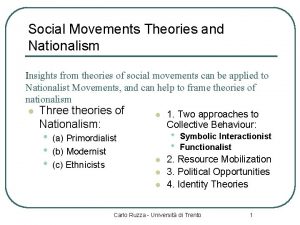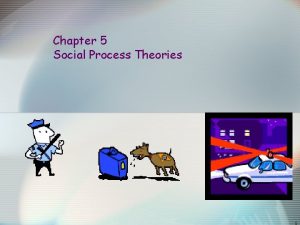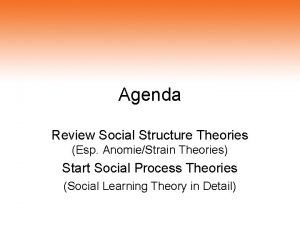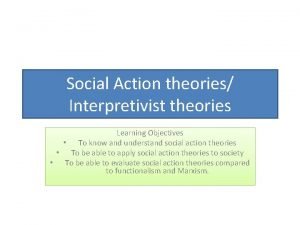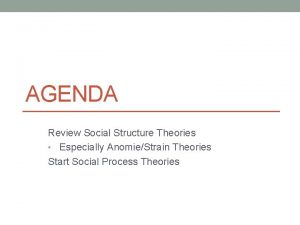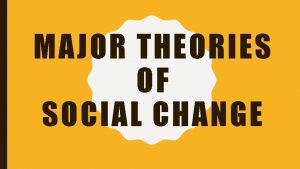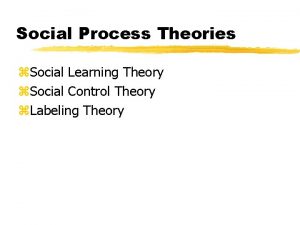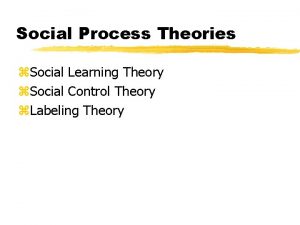Chapter 8 Theories of Social Process and Social



















































- Slides: 51

Chapter 8 Theories of Social Process and Social Development Frank Schmalleger Power. Point presentation created by Ellen G. Cohn, Ph. D.

The Social Process Perspective n Social process theories (Interactionist perspective) n n n Depend on the process of interaction between individuals and society Assume everyone has the power to violate the law and criminality is not an innate human characteristic Criminal behavior is learned in interaction with others, primarily through socialization Criminology Today, 5 th ed Frank Schmalleger 2 © 2009 Pearson Education, Upper Saddle River, NJ 07458. All Rights Reserved.

Types of Social Process Approaches n Social learning theory n Social control theory n Labeling theory n Reintegrative shaming n Dramaturgy Criminology Today, 5 th ed Frank Schmalleger 3 © 2009 Pearson Education, Upper Saddle River, NJ 07458. All Rights Reserved.

Theory in Perspective n Social learning theory n n n All behavior is learned in much the same way and crime, like other forms of behavior, is also learned Period: 1930 s – present Concepts: Differential association, differential association-reinforcement, operant conditioning, differential identification Criminology Today, 5 th ed Frank Schmalleger 4 © 2009 Pearson Education, Upper Saddle River, NJ 07458. All Rights Reserved.

Differential Association n Edwin Sutherland n n Crime is learned through a process of differential association with others who communicate criminal values and advocate the commission of crimes Suggests crime is not substantially different from other forms of behavior Criminology Today, 5 th ed Frank Schmalleger 5 © 2009 Pearson Education, Upper Saddle River, NJ 07458. All Rights Reserved.

Key Principles of Differential Association n Criminal behavior is learned in interaction with other persons in a process of communication The principal part of the learning of criminal behavior occurs within intimate personal groups Criminology Today, 5 th ed Frank Schmalleger 6 © 2009 Pearson Education, Upper Saddle River, NJ 07458. All Rights Reserved.

Key Principles of Differential Association n The learning includes techniques of committing the crime and the specific direction of motives, drives, rationalizations, and attitudes The specific direction of motives and drives is learned from definitions of the legal codes as favorable or unfavorable A person becomes delinquent because of an excess of definitions favorable to violation of law over definitions unfavorable to violation of law Criminology Today, 5 th ed Frank Schmalleger 7 © 2009 Pearson Education, Upper Saddle River, NJ 07458. All Rights Reserved.

Key Principles of Differential Association n Differential associations may vary in frequency, duration, priority, and intensity The process of learning criminal behavior by association with criminal and anticriminal patterns involves all of the mechanisms that are involved in any other learning While criminal behavior is an expression of general needs and values, it is not explained by those general needs and values Criminology Today, 5 th ed Frank Schmalleger 8 © 2009 Pearson Education, Upper Saddle River, NJ 07458. All Rights Reserved.

Differential Association. Reinforcement Theory n Robert Burgess and Ronald Akers (1966) n n Adds the concept of reinforcement to theory of differential association Human beings learn to define behaviors that are rewarded as positive and an individual’s criminal behavior is rewarded by individuals and groups that value such activity Criminology Today, 5 th ed Frank Schmalleger 9 © 2009 Pearson Education, Upper Saddle River, NJ 07458. All Rights Reserved.

Differential Association. Reinforcement Theory n n The same learning process produces both conforming and deviant behavior Primary learning mechanisms n n Differential reinforcement (instrumental conditioning) Imitation Criminology Today, 5 th ed Frank Schmalleger 10 © 2009 Pearson Education, Upper Saddle River, NJ 07458. All Rights Reserved.

Differential Identification Theory Daniel Glaser n n n A person pursues criminal behavior to the extent that he identifies with real or imaginary persons from whose perspective his criminal behavior seems acceptable The process of differential association leads to intimate personal identification with lawbreakers, resulting in criminal acts Criminology Today, 5 th ed Frank Schmalleger 11 © 2009 Pearson Education, Upper Saddle River, NJ 07458. All Rights Reserved.

Theory in Perspective n Social control theory n n Focuses on the strength of the bond that people share with institutions and individuals around them Seeks to identify features of personality and environment that keep people from committing crimes Period: 1950 s – present Concepts: inner and outer containment, selfderogation, social bond, control-balance Criminology Today, 5 th ed Frank Schmalleger 12 © 2009 Pearson Education, Upper Saddle River, NJ 07458. All Rights Reserved.

Social Control Theories n n n Seek identifying factors that keep people from committing crimes Focus on the process through which integration with positive institutions and individuals develops Asks why people obey rules instead of breaking them Criminology Today, 5 th ed Frank Schmalleger 13 © 2009 Pearson Education, Upper Saddle River, NJ 07458. All Rights Reserved.

Containment Theory Walter Reckless n n n Crime is the consequence of social pressures to involve oneself in violations of the law, as well as of failure to resist such pressures Compares crime with biological immune response n n Only some people exposed to a disease come down with it Only some people exposed to social pressures to commit crime violate the law Criminology Today, 5 th ed Frank Schmalleger 14 © 2009 Pearson Education, Upper Saddle River, NJ 07458. All Rights Reserved.

Containment Theory n External containment: The holding power of the group to keep the individual within the bounds of conventional norms n Inner containment: The ability of a person to follow expected norms, to direct himself Criminology Today, 5 th ed Frank Schmalleger 15 © 2009 Pearson Education, Upper Saddle River, NJ 07458. All Rights Reserved.

Containment Theory n Pushes toward crime Factors in an individual’s background that propel him into crime n Pulls toward crime Perceived rewards offered by crime n Containment is a stabilizing force that blocks pushes and pulls from leading the individual toward crime Criminology Today, 5 th ed Frank Schmalleger 16 © 2009 Pearson Education, Upper Saddle River, NJ 07458. All Rights Reserved.

A Diagrammatic Representation of Containment Theory Criminology Today, 5 th ed Frank Schmalleger 17 © 2009 Pearson Education, Upper Saddle River, NJ 07458. All Rights Reserved.

Delinquency and Self. Esteem n Howard Kaplan’s self-derogation theory of delinquency People who are ridiculed by their peers suffer a loss of self-esteem, assess themselves poorly, and abandon the motivation to conform. Criminology Today, 5 th ed Frank Schmalleger 18 © 2009 Pearson Education, Upper Saddle River, NJ 07458. All Rights Reserved.

Social Bond Theory n Travis Hirschi (1969) n n Through successful socialization, a bond forms between individuals and the social group When the bond is weakened or broken, deviance and crime may result Criminology Today, 5 th ed Frank Schmalleger 19 © 2009 Pearson Education, Upper Saddle River, NJ 07458. All Rights Reserved.

Components of the Social Bond n Attachment: A person’s shared interests with others n Commitment: The amount of energy and effort put into activities with others n Involvement: The amount of time spent with others in shared activities n Belief: A shared value and moral system Criminology Today, 5 th ed Frank Schmalleger 20 © 2009 Pearson Education, Upper Saddle River, NJ 07458. All Rights Reserved.

General Theory of Crime n Hirschi and Gottfredson (1990) n n n Most crimes are aimed at satisfying desires of the moment Crime is a national consequence of unrestrained human tendencies to seek pleasure and avoid pain Self-control is the key concept in the explanation of all forms of crime Criminology Today, 5 th ed Frank Schmalleger 21 © 2009 Pearson Education, Upper Saddle River, NJ 07458. All Rights Reserved.

Control-Balance Theory n n Charles Tittle Control ratio n n The amount of control to which a person is subject versus the amount of control that person exerts over others Predicts the probability one will engage in deviance and the specific form it will take Criminology Today, 5 th ed Frank Schmalleger 22 © 2009 Pearson Education, Upper Saddle River, NJ 07458. All Rights Reserved.

Theory in Perspective n Labeling theory (societal reaction theory) n n n Continued crime is a consequence of limited opportunities for acceptable behavior that follow from the negative responses of society to those defined as offenders Period: 1938 – 1940, 1960 s – 1980, 1990 s revival Concepts: Tagging, labeling, outsiders, moral enterprise, primary and secondary deviance, reintegrative shaming, stigmatic shaming Criminology Today, 5 th ed Frank Schmalleger 23 © 2009 Pearson Education, Upper Saddle River, NJ 07458. All Rights Reserved.

Labeling Theory n Tagging: The process whereby an individual is negatively defined by agencies of justice n Dramatization of evil: The process whereby an offender comes to be seen as ultimately and irrevocably “bad” Criminology Today, 5 th ed Frank Schmalleger 24 © 2009 Pearson Education, Upper Saddle River, NJ 07458. All Rights Reserved.

Labeling Theory n Primary deviance: Initial deviance undertaken to solve an immediate problem or meet the expectations of one’s subcultural group n Secondary deviance: Deviant behavior that results from official labeling and from association with others who have been so labeled Criminology Today, 5 th ed Frank Schmalleger 25 © 2009 Pearson Education, Upper Saddle River, NJ 07458. All Rights Reserved.

Labeling Theory n Howard Becker (1963) – Outsiders n n Deviance is a social product created by society Deviance is not a quality of the act but a consequence of the application by others of rules and sanctions A deviant is one who has been so labeled Moral enterprise Criminology Today, 5 th ed Frank Schmalleger 26 © 2009 Pearson Education, Upper Saddle River, NJ 07458. All Rights Reserved.

Key Contributions of Labeling Theory n n Deviance is the result of social processes involving the imposition of definitions, rather than the consequence of any quality inherent in human activity Deviant individuals achieve their status by virtue of social definition, rather than because of inborn traits Criminology Today, 5 th ed Frank Schmalleger 27 © 2009 Pearson Education, Upper Saddle River, NJ 07458. All Rights Reserved.

Key Contributions of Labeling Theory n n n The reaction of society to deviant behavior and actors who engage in such behavior is the major element in determining the criminality of the person and behavior Negative self-images follow from processing by the formal mechanisms of criminal justice Labeling by society and handling by the justice system perpetuate crime rather than reduce it Criminology Today, 5 th ed Frank Schmalleger 28 © 2009 Pearson Education, Upper Saddle River, NJ 07458. All Rights Reserved.

Typology of Delinquents n n n Pure deviant: commits norm-breaking behavior and whose behavior is accurately appraised as such by society Falsely accused deviant: is not guilty but is labeled “deviant” anyway Secret deviant: norm-violating behavior is noticed and negative social reactions do not follow Criminology Today, 5 th ed Frank Schmalleger 29 © 2009 Pearson Education, Upper Saddle River, NJ 07458. All Rights Reserved.

Reintegrative Shaming n John Braithwaite n n n Emphasizes processes by which a deviant is labeled and sanctioned but then brought back into a community of conformity through words, gestures, or rituals Restorative justice approach Condemn the crime, not the criminal Criminology Today, 5 th ed Frank Schmalleger 30 © 2009 Pearson Education, Upper Saddle River, NJ 07458. All Rights Reserved.

Reintegrative Shaming n Stigmatic shaming: A form of shaming, imposed as a sanction by the criminal justice system, that is thought to destroy the moral bond between the offender and the community n Reintegrative shaming: A form of shaming, imposed as a sanction by the criminal justice system, that is thought to strengthen the moral bond between the offender and the community Criminology Today, 5 th ed Frank Schmalleger 31 © 2009 Pearson Education, Upper Saddle River, NJ 07458. All Rights Reserved.

Theory in Perspective n Dramaturgy n n Depicts human behavior as centered around the purposeful management of impressions Seeks explanatory power in the analysis of social performances Period: 1960 s – present Concepts: Total institutions, impression management, back and front regions, performances, discrediting information, stigma, spoiled identity Criminology Today, 5 th ed Frank Schmalleger 32 © 2009 Pearson Education, Upper Saddle River, NJ 07458. All Rights Reserved.

Dramaturgy n Erving Goffman – dramaturgical perspective n n n Individuals play a variety of nearly simultaneous social roles Roles are sustained in interaction with others Impression management: The intentional enactment of practiced behavior intended to convey to others one’s desirable personal characteristics and social qualities Criminology Today, 5 th ed Frank Schmalleger 33 © 2009 Pearson Education, Upper Saddle River, NJ 07458. All Rights Reserved.

Dramaturgy n Discrediting information: Information that is inconsistent with the managed impressions being communicated in a given situation n Total institution: An institution from which individuals can rarely come and go and in which communal life is intense and circumscribed Criminology Today, 5 th ed Frank Schmalleger 34 © 2009 Pearson Education, Upper Saddle River, NJ 07458. All Rights Reserved.

Theory in Perspective n Life course theories n n n Highlight the development of criminal careers, which are seen as the result of various criminogenic influences affecting individuals throughout the course of their lives Period: 1980 s – present Concepts: Criminal career, life course, trajectory, turning points, age grading, social capital, developmental pathways, life course persisters, adolescence-limited offenders, persistence, desistance Criminology Today, 5 th ed Frank Schmalleger 35 © 2009 Pearson Education, Upper Saddle River, NJ 07458. All Rights Reserved.

The Life Course Perspective n n Focuses on the dimensions of criminal offending over the entire life course Criminal career The longitudinal sequence of crimes committed by an individual offender Participation Duration Frequency Seriousness Criminology Today, 5 th ed Frank Schmalleger 36 © 2009 Pearson Education, Upper Saddle River, NJ 07458. All Rights Reserved.

The Life Course Perspective n Life course: Pathways through the life span involving a sequence of culturally defined age-graded roles and social transitions enacted over time n Focus on trajectories and transitions through the age-differentiated life span Criminology Today, 5 th ed Frank Schmalleger 37 © 2009 Pearson Education, Upper Saddle River, NJ 07458. All Rights Reserved.

Life Course Perspective n Activation: The ways that delinquent behaviors are stimulated and the processes by which the continuity, frequency, and diversity of delinquency are shaped n Aggravation: The existence of a developmental sequence of activities that escalate or increase in seriousness over time n Desistance: A reduction in the frequency of offending, variety, or seriousness Criminology Today, 5 th ed Frank Schmalleger 38 © 2009 Pearson Education, Upper Saddle River, NJ 07458. All Rights Reserved.

Laub and Sampson’s Age. Graded Theory n Age-graded theory of informal social control n n Delinquency is more likely to occur when bonds to society are weakened or broken Social ties embedded in adult transitions explain variations in crime not accounted for by childhood deviance Criminology Today, 5 th ed Frank Schmalleger 39 © 2009 Pearson Education, Upper Saddle River, NJ 07458. All Rights Reserved.

Laub and Sampson’s Age. Graded Theory n Key turning points n n Employment – Marriage Social capital: The degree of positive relationships that individuals build up over the course of their lives Criminology Today, 5 th ed Frank Schmalleger 40 © 2009 Pearson Education, Upper Saddle River, NJ 07458. All Rights Reserved.

Moffitt’s Dual Taxonomic Theory n Life course persisters: As a result of neuropsychological deficits (early brain damage or chemical imbalances) combined with poverty and family dysfunction, some people come to display more or less constant patterns of misbehavior throughout life n Adolescence-limited offenders: Individuals who go through limited periods where they exhibit high probabilities of offending; they are led to offending primarily by structural disadvantages Criminology Today, 5 th ed Frank Schmalleger 41 © 2009 Pearson Education, Upper Saddle River, NJ 07458. All Rights Reserved.

Farrington’s Delinquent Development Theory n Persistence: n n Continuity in crime Desistance: n The cessation of criminal activity or the termination of a period of involvement in criminal behavior n n Unaided – no formal intervention involved Aided – involves agencies of the justice system Criminology Today, 5 th ed Frank Schmalleger 42 © 2009 Pearson Education, Upper Saddle River, NJ 07458. All Rights Reserved.

Farrington’s Delinquent Development Theory Cambridge Study in Delinquent Development n n n Cohort of 411 boys born in London in 1953 Attempts to explain the heterogeneity of developmental pathways Persistent offenders suffer from a variety of risk factors for delinquency (hyperactivity, broken homes, low family income, harsh discipline, etc. ) Offending peaks at age 17 or 18 and then declines; by age 35, many subjects had assumed conforming lifestyles Criminology Today, 5 th ed Frank Schmalleger 43 © 2009 Pearson Education, Upper Saddle River, NJ 07458. All Rights Reserved.

Farrington’s Delinquent Development Theory n Components of desistance n Deceleration n Specialization n Deescalation n Reaching a ceiling Criminology Today, 5 th ed Frank Schmalleger 44 © 2009 Pearson Education, Upper Saddle River, NJ 07458. All Rights Reserved.

Evolutionary Ecology n Lawrence Cohen and Richard Machalek n n Draws attention to the ways people develop over the course of their lives Attempts to explain how people acquire criminality, when and why they express it as crime, how individuals and groups respond to crimes, and how these phenomena interact Criminology Today, 5 th ed Frank Schmalleger 45 © 2009 Pearson Education, Upper Saddle River, NJ 07458. All Rights Reserved.

Thornberry’s Interactional Theory n Interactional theory The fundamental cause of delinquency is a weakening of a person’s bond to conventional society combined with the presence of an environment in which delinquency can be learned and in which rule-violating behavior can be positively rewarded Criminology Today, 5 th ed Frank Schmalleger 46 © 2009 Pearson Education, Upper Saddle River, NJ 07458. All Rights Reserved.

Developmental Pathways n n Manifestations of disruptive behaviors in childhood and adolescence are often age dependent Program of Research on the Causes and Correlates of Delinquency n n Focus on improving understanding of serious delinquency, violence, and drug use Examines how youths develop within the context of family, school, peers, and community Criminology Today, 5 th ed Frank Schmalleger 47 © 2009 Pearson Education, Upper Saddle River, NJ 07458. All Rights Reserved.

Three Pathways to Disruptive Behavior and Delinquency Criminology Today, 5 th ed Frank Schmalleger 48 © 2009 Pearson Education, Upper Saddle River, NJ 07458. All Rights Reserved.

The Chicago Human Development Project n n n A longitudinal analysis of how individuals, families, institutions, and communities evolve together Traces how criminal behavior evolves from birth to age 32 Early results have led to targeted interventions intended to lower rates of offending Criminology Today, 5 th ed Frank Schmalleger 49 © 2009 Pearson Education, Upper Saddle River, NJ 07458. All Rights Reserved.

Policy Implications of Social Development Theories OJJDP’s Comprehensive Strategy Program n n Provides participating communities with a framework for preventing delinquency, intervening in early delinquent behavior, and responding to serious, violent, and chronic offending Targeted Outreach program (Boys and Girls Clubs of America) n n Diverts at-risk juveniles into activities intended to develop a sense of belonging, competence, usefulness, and self-control Criminology Today, 5 th ed Frank Schmalleger 50 © 2009 Pearson Education, Upper Saddle River, NJ 07458. All Rights Reserved.

Critique of Social Development Theories n n Definitional issues and problems Difficulties in developing risk/needs assessment devices and in using them in both fundamental (pure) and applied research Criminology Today, 5 th ed Frank Schmalleger 51 © 2009 Pearson Education, Upper Saddle River, NJ 07458. All Rights Reserved.
 Miller's focal concerns
Miller's focal concerns Social process theories criminology
Social process theories criminology Differential association example
Differential association example Primary and secondary deviance
Primary and secondary deviance Social process theory
Social process theory Theories of communication in health and social care
Theories of communication in health and social care Theories of communication in health and social care
Theories of communication in health and social care Child development principles
Child development principles Chapter 6 - theories of international trade and investment
Chapter 6 - theories of international trade and investment Social action theory examples
Social action theory examples Social thinking and attribution theory
Social thinking and attribution theory Theories of social change
Theories of social change Theories for direct social work practice
Theories for direct social work practice Social structure theories
Social structure theories Theories of social responsibility
Theories of social responsibility Family social science theories
Family social science theories Factors of social change
Factors of social change Interpersonal attraction psychology
Interpersonal attraction psychology What does the psychoanalytic approach to personality teach?
What does the psychoanalytic approach to personality teach? Seeding theory of mineralization
Seeding theory of mineralization Chapter 11 developmental theories
Chapter 11 developmental theories Chapter 3 applying learning theories to healthcare practice
Chapter 3 applying learning theories to healthcare practice Social thinking adalah
Social thinking adalah Social thinking social influence social relations
Social thinking social influence social relations Theories and values of positive practice
Theories and values of positive practice Principles of human growth and development
Principles of human growth and development Leadership grid
Leadership grid Molecular geometry and bonding theories
Molecular geometry and bonding theories The electra complex
The electra complex Permit easy reversal of actions
Permit easy reversal of actions Learning theories and program design
Learning theories and program design Nursing theories
Nursing theories Chomsky vs piaget
Chomsky vs piaget Global marketing theories
Global marketing theories Von thunens theory
Von thunens theory Piagetian and information processing theories 8-18 months
Piagetian and information processing theories 8-18 months Nursing informatics theories, models and frameworks
Nursing informatics theories, models and frameworks Merton's strain theory
Merton's strain theory Trait theory of personality
Trait theory of personality Theories of culture and communication
Theories of culture and communication Module 23 sleep patterns and sleep theories
Module 23 sleep patterns and sleep theories Molecular geometry and bonding theories
Molecular geometry and bonding theories Demography ap human geography
Demography ap human geography Theories of normal and abnormal development
Theories of normal and abnormal development Theories of international trade and investment
Theories of international trade and investment Glasser classroom management
Glasser classroom management Geocentrism vs heliocentrism
Geocentrism vs heliocentrism Opponent process theory vs trichromatic theory
Opponent process theory vs trichromatic theory Management models and theories
Management models and theories Educational theorists and their theories
Educational theorists and their theories Module 23 sleep patterns and sleep theories
Module 23 sleep patterns and sleep theories Module 23 sleep patterns and sleep theories
Module 23 sleep patterns and sleep theories
